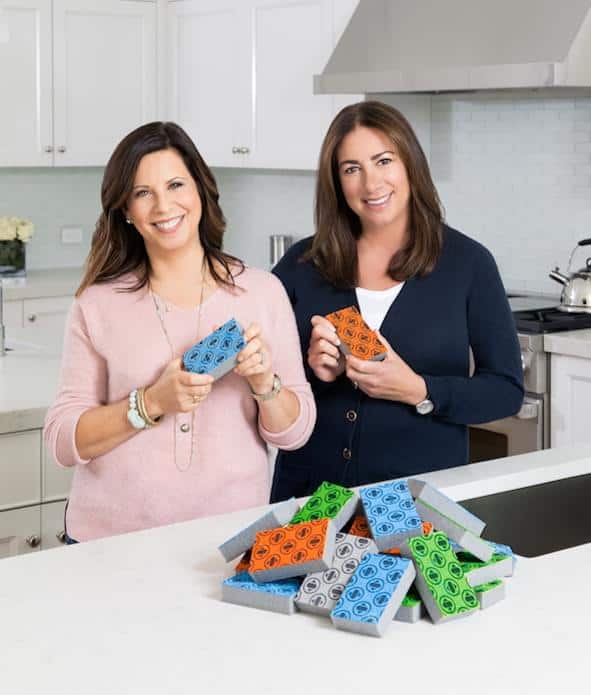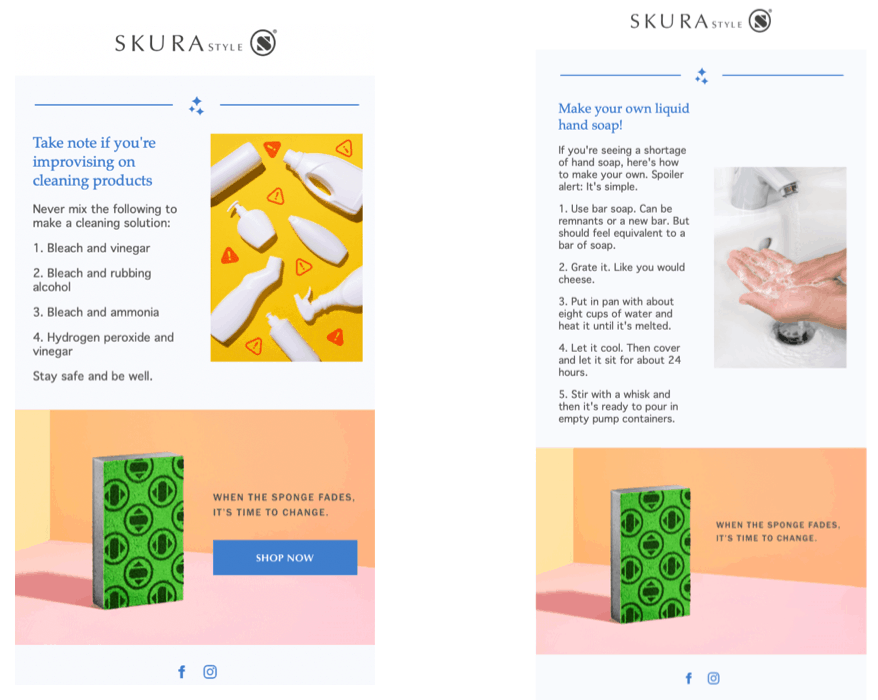Kitchen sponge retailer Skura Style was born out of utter disgust—the co-founders’ disgust for kitchen and dishwashing sponges that are hubs of bacteria living on consumers’ counters.
Traditional sponges are made of cellulose and non-woven fiber, which make for a good cleaning tool but are anything but clean, according to president and co-founder Alison Matz. Matz cites a study that traditional sponges can be 200,000 times dirtier than a toilet seat, according to a study from research firm Scientific Reports. Skura Style, on the other hand, makes its sponges out of polyurethane foam, which dries more quickly, retains its shape, inhibits the growth of bacteria, mold and mildew and has a strong scouring side, according to Matz.

Skura Style co-founders Alison Matz and Linda Sawyer
The sponge retailer launched in October 2017 as a direct-to-consumer ecommerce site on SkuraStyle.com—the name coming from the Swedish word skura, which means to scour and scrub. And it began with a subscription model to help consumers remember to change their sponge every 1-2 weeks. Skura Style sponges also are equipped with a monogram design that fades with use as a visual reminder to change the sponge.
Even though its sponges inhibit the growth of bacteria better than a traditional sponge, they should still be changed at a regular cadence like any other sponge, Matz says.
Skura Style’s sponges come in a pack of four sponges, and consumers can sign up for a pack to arrive every month or every other month.
After having this subscription model for a year, Skura Style expanded in October 2018 and began selling single packs of four sponges on Amazon.com. Now, about 30% of its sales come from Amazon, while 60% come from its own site. (The other 10% comes from other ecommerce sites the retailer sells on, but it did not disclose which ones.)
“The Amazon launch was part of a master omnichannel plan to have our product available where people shopped and how they wanted it to arrive,” Matz says. “That has really been additive to our customer base.”
Skura Style also added a stock-up option in which shoppers can purchase a box of 12 sponges or a box of 16 sponges at one time.
Anti-bacterial needs in an anti-viral world
When the coronavirus pandemic swept the U.S., causing consumers to stock up on cleaning supplies, Skura Style saw a huge spike in sales. Online sales grew 150% from mid-March to mid-May compared with the same period in 2019, Matz says without providing exact sales figures.
“People who normally didn’t buy a lot of things or essential items in ecommerce, they’re coming to realize the convenience of it,” Matz says.
Skura Style didn’t experience any significant drawbacks in manufacturing, fulfillment or delivery during the pandemic, as some retailers seemed to struggle with. Its product is made in North Carolina, which is also where its fulfillment warehouse is based.
“We’ve had minor slowdowns with packaging elements based on labor shortages with people staying home, but nothing really significant,” Matz says.
And even though Skura Style values selling on Amazon, the ecommerce giant’s delivery challenges during the pandemic drove people to seek its direct-to-consumer options, Matz says.
As more consumers were sheltering in place and spending time cooking and cleaning at home, Skura Style found that many of its customers also changed the frequency of their subscription plan to monthly as opposed to the more popular every-other-month plan. Additionally, those subscription customers have added stock-up packages to their existing plans, Matz says.
Despite the growth in sales, Skura Style’s marketing strategy remains unchanged. “Our message is about the product. The difference is that it seems to resonate now more than ever before,” Matz says.
Skura Style does a lot of email marketing with “really great open rates,” Matz says without revealing more. Every Sunday, it sends a newsletter cleaning kit with a reminder that it might be time to change the sponge—complete with a “cute” gif. Its newsletter is not always sponge-related. For example, it sent one with information on how to make hand sanitizer and hand soap at home when the products were in high demand.

It also uses Facebook and Instagram, both paid and organic, as well as radio advertisements on Sirius XM. Matz and her co-founder (and childhood best friend) Linda Sawyer do the voiceover for the commercial of “two women taking on big sponge,” Matz says.
In its marketing messages, the sponge retailer has been careful not to suggest that its product is anti-viral since it will not prevent anything to do with COVID-19, but that it is anti-bacterial and will inhibit the growth of bacteria on the sponge, on kitchen counters and on dishes.
“We’ve always been in the business of kitchen well-being, and that’s a message we believe in because it is timeless in its relevancy,” Matz says.
